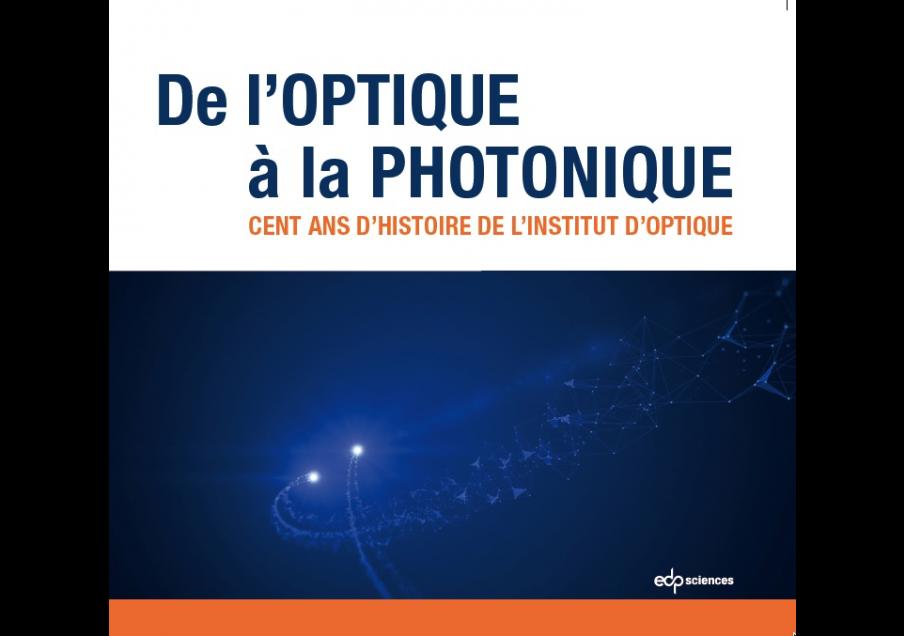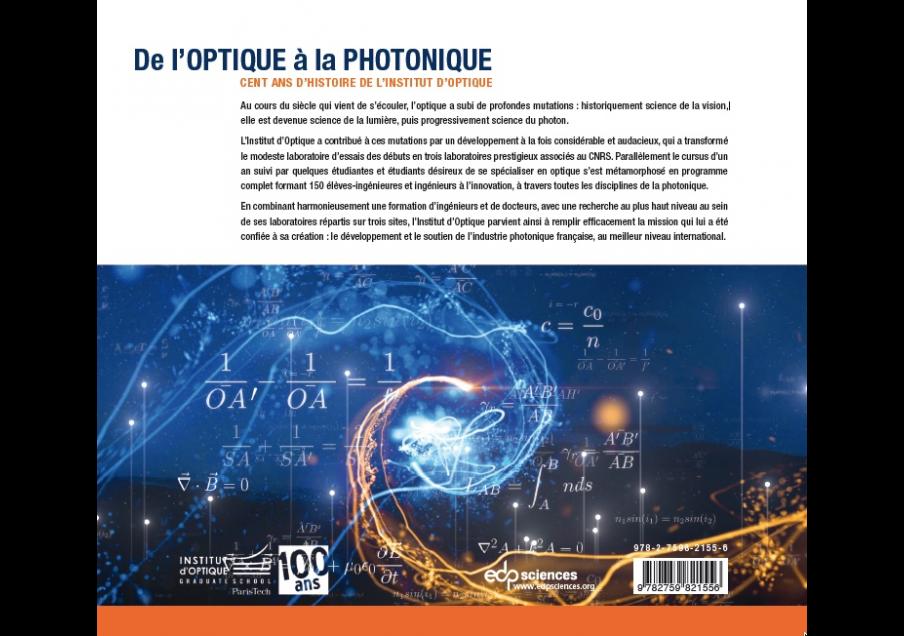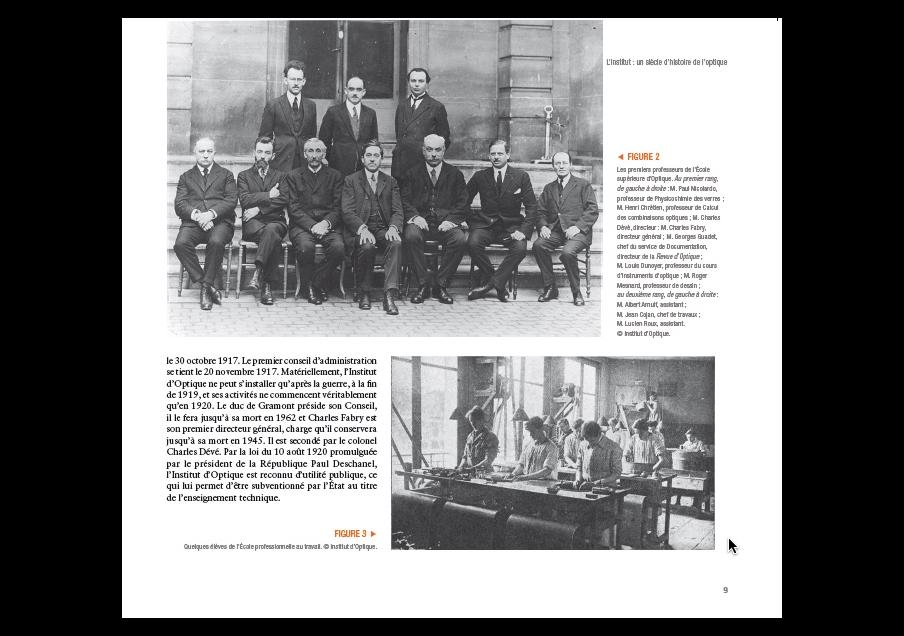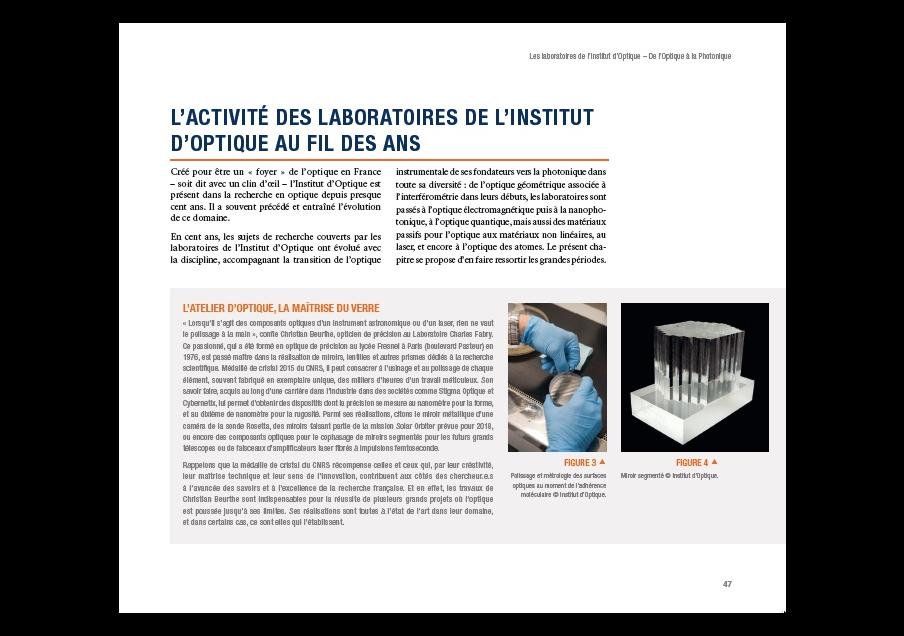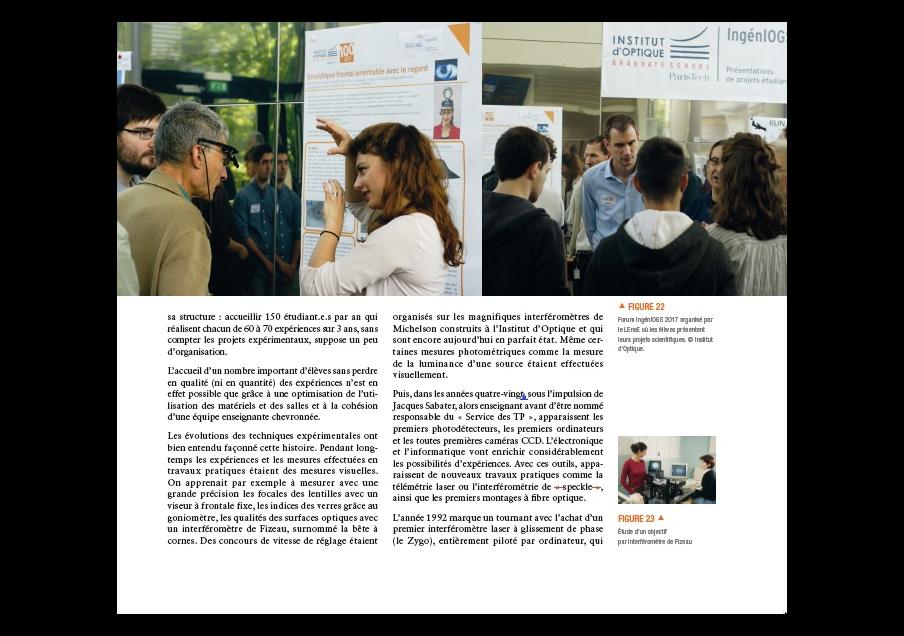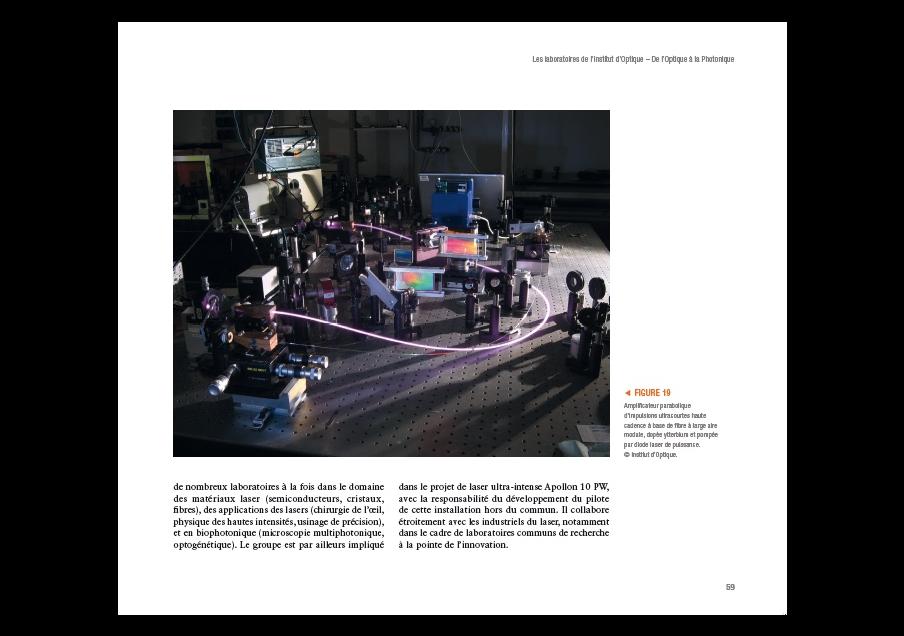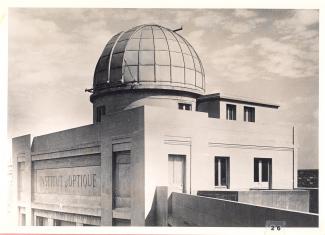History
To celebrate its 100th anniversary, the Institut d'Optique and its partners have collaborated to edit and publish a book tracing its journey. This is a remarkable example of the dynamic interplay between fundamental research, education, and industrial innovations.
To order the book, please write to communication@institutoptique.fr.
Book Celebrating 100 years At l'Institut d'Optique Graduate School
Histoire de l'Institut d'Optique
Création Creation of the Institute
1916 : Commission interministérielle Interministerial Comission
1917 : Création de l'Institut d'Optique Creation of the Institut d'Optique
1920 : Loi fondatrice de l'Institut d'Optique Founding Law of the Institut d'Optique
1926 : Bâtiment du boulevard Pasteur Building on Boulevard Pasteur
1940 - 1944 : La seconde guerre mondiale World War II
1967 : Nouveau bâtiment à Orsay New Building in Orsay
1984 - 1998 : Christian Imbert
De 2006 à nos jours : Jean-Louis Martin from 2006- Present: Jean Louis Martin
Création, Creation of the Institut
During the First World War, in 1915, the need for optical instruments became particularly acute, and France lacked the engineers to calculate their components. Duke Armand de Gramont, then serving in the military, was alarmed by this situation and, along with other like-minded individuals, advocated for the creation of an Institute of Optics dedicated to teaching instrumental optics.
1916 - Commission interministérielle, Interministerial Commission
In 1916, Armand de Gramont and Henri Chrétien, an engineering optician, developed a project that they presented to Paul Painlevé, Minister of Public Instruction, Fine Arts, and Inventions, which was of interest to National Defense. The latter convinced his ministerial colleagues from Commerce, War, and the Navy to create an interministerial commission. Its presidency was entrusted to General Bourgeois, head of the Army's Geographic Service, where all of France's optical industry production was then centralized. This creation was the subject of a decree published in the Official Journal on November 16, 1916. This commission was responsible for developing the status and program of an "Applied Optics Institute" in Paris. 1917 - Creation of the Institute of Optics.
1917 : Création de l'Institut d'Optique, Creation of the Institut d'Optique
In 1917, three administrators (Jobin, de Gramont, and Violle) were appointed to file the declaration of opening and hold an initial board meeting to draft bylaws. The preliminary declaration for the opening of an "Institute of Optics" was filed on October 30, 1917. The first board of directors meeting was held on November 20, 1917.
1920 - Loi fondatrice de l'Institut d'Optique
It wasn't until the end of 1919, after the war, that the Institute of Optics could be physically established and begin its operations. The Duke of Gramont chaired its Council until his death in 1962, and the physicist Charles Fabry served as its first Director General until 1945. The law passed on August 10th, 1920, signed by President Paul Deschanel, the Institute of Optics was officially recognized as a public interest organization, making it eligible for government funding under the Technical Education program.
At its inception, under the General Management of Charles Fabry and the Direction of Charles Dévé, the Institute of Optics was housed in the premises of 140 Boulevard du Montparnasse, previously occupied by the École d'Application du Génie Maritime before the war. Its scientific activities remained modest during the first years. The verifications and measurements produced at the request of the industry focused on:
- the study of substances (one did not yet say "materials") - reflection, refraction, dispersion, birefringence, homogeneity, dilatometry, etc.
- the study of shapes (flatness, curvature, angles, graduation),
- the study of images (aberrations),
- the verification of instruments (photographic lenses, binoculars, telescopes, laboratory equipment, sextants, eyewear),
- the spectral analysis of the emission of sources.
With Georges Guadet, Charles Fabry took over the old Revue Générale d'Optique et de Mécanique de Précision and created the Revue d'Optique Théorique et Instrumentale.
1926 : Bâtiment du boulevard Pasteur, Building on Boulevard Pasteur
As the Institute of Optics expanded its activities, it required more space. In August 1926, it relocated to larger, better-equipped facilities on Boulevard Pasteur. These new premises were officially opened on March 18, 1927, by Edouard Herriot, the Minister of Public Instruction, with President Gaston Doumergue in attendance. Here, the institute could delve deeper into fundamental physics research, complementing its existing work in verification and measurement.
1940 - 1944 : La seconde guerre mondiale, The Second World War
Due to its involvement in military projects, the Institute of Optics was evacuated by the French Navy in July 1940 to the Côte d'Azur near Saint-Cyr-sur-Mer, where it was housed at the Hôtel des Palmiers. While part of the institute moved, teaching activities continued in Paris under the leadership of Pierre Fleury. André Maréchal and Maurice Françon joined the institute during this period. Research focused on photometry, spectrophotometry, and colorimetry, driven by Fleury's expertise. The school gradually shifted its focus from applied optics to fundamental physics, leading to a two-year curriculum in 1942.
After World War II and the passing of Charles Fabry in 1945, Pierre Fleury became the institute's director general, with Albert Arnulf heading the laboratories. The institute's focus shifted towards research, facilitated by the newly established CNRS, which assigned engineers and researchers like Georges Nomarski and Florin Abelès. In 1966, the Institut d'Optique became one of the first CNRS-associated laboratories. At the School, the curriculum was extended to three years in 1952, with admissions based on competitive exams shared with Supélec and later, the Écoles Centrales. The third cycle was introduced in 1957, along with the advanced optics certificate. The vocational school moved to 31 Boulevard Pasteur in 1957, later becoming the Lycée Fresnel. The "Opticians' Meetings" organized by Pierre Fleury in 1946 marked the beginning of the International Commission for Optics (ICO). Twenty years later, the institute hosted the ICO's seventh plenary meeting at UNESCO headquarters.
Note:
- DEA : Diplôme d'Études Approfondies (Advanced Studies Diploma) - a former French graduate degree.
- CNRS : Centre National de la Recherche Scientifique (National Center for Scientific Research)
1967 : Nouveau bâtiment à Orsay, A New Building in Orsay
Due to overcrowding, some teams had to relocate to the Halle aux Vins. Pierre Fleury proposed a rebuild on the current site, but the plan was unsuccessful. A new building was eventually constructed in Orsay and inaugurated on January 31, 1967, with Alain Peyreffite, Minister of Scientific and Technical Research, and Alfred Kastler, the 1966 Nobel laureate, and the institute's president, in attendance. Starting in 1966, several teams, including those of Serge Lowenthal and Jacques Ducuing, moved to Orsay to join the school.
André Maréchal, formerly the Delegate General for Scientific and Technical Research, became the new director in January 1968, following Pierre Fleury. He was elected to the Academy of Sciences in 1981. Michel Cagnet served as the school's Director of Studies under Maréchal's leadership.
1968 - A Logo
Due to its expanded presence at multiple locations (Paris and Orsay), the Institute required a unified visual identity. The interlocking I and O logo was created to fulfill this need.
Research: the laser's arrival at the Institut d'Optique revolutionized research topics. However, this period is perhaps most notable for a new orientation towards the study of fundamental phenomena: evanescent waves were studied in depth, optical levitation enabled the micromanipulation of targets, the spin-orbit interaction of light was visualized by Christian Imbert, and the principle of quantum non-locality was confirmed by Alain Aspect. Teaching followed the same trend as research, with the introduction of courses on more fundamental disciplines. The dissemination of optics remains a major goal of the Institut d'Optique. In 1980, it organized the first "Horizons of Optics" colloquium under the auspices of the French Committee for Optics. From 1983, this conference became the biennial meeting of the French Society of Optics, whose creation had been proposed by Georges Guadet, director of the Revue d'Optique, in 1925.
1976 - Extension du bâtiment
A second phase was added to the Orsay building a decade later, bringing together all the remaining Parisian teams with those already based in Orsay.
1984 - 1998 : Christian Imbert
The fourth director, Christian Imbert, assumed his duties in January 1984. He was well-versed in the institute's operations, having spent his entire research career there. Starting in January 1998, Christian Imbert sought assistance by proposing Pierre Chavel to the CNRS as director of the laboratory, which would subsequently be named the Charles Fabry Laboratory of the Institute of Optics. At the head of the school's studies department, Jean Taboury gradually replaced Michel Cagnet, who was retiring.
1995 - A New Logo
To promote greater unity within the Institute, Christian Imbert decided to unify all its activities (laboratory, school, etc.) under a single logo that would be used in all events.
At the laboratory, the research topics developed followed the general evolution of optics. The available sources and detectors became increasingly efficient, and materials increasingly sophisticated. These, combined with shaping and integration techniques, led to the exceptional development of nonlinear optics and opened the way to new fields such as optoelectronics, optronics, and integrated optics.
For original components and optical instrumentation, trends shifted from visible wavelengths to UV, and X-ray ranges continued. Moreover, intensive research was conducted in quantum optics, manipulating light using the nonlinear properties of materials to achieve, for example, a reduction in the quantum noise of laser beams.
Conversely, in the new discipline of atomic optics, laser waves were used to manipulate and trap atoms. The school's teaching introduced a significant innovation: in the second year, students could choose between the traditional track and apprenticeship-based training.
The traditional track followed the school year's rhythm, including periods of projects and internships in companies. Apprentices were employed by companies and alternated between work periods in companies and training periods at the CFA SupOptique.
The French Society of Optics was founded at the end of 1983 by Christian Imbert and several university and industrial partners. Christian Imbert then took an active role in the launch of the European Optical Society, where he served as the second treasurer, and whose headquarters were located at the Institute of Optics. Christian Imbert was tragically struck by a heart attack in October 1998, leaving his colleagues and students in dismay.
Bernard Cagnac's Interim
The president of the board of directors, Bernard Cagnac, served as interim director while preparing for the appointment of a new director.
The fifth Director General, André Ducasse, took office in February 1999. He expanded the leadership team in consultation with Pierre Chavel, Director of the Charles Fabry Laboratory:
- Gérald Roosen was appointed Deputy Director of the Laboratory
- Jean-Michel Jonathan became Deputy Director of the École Supérieure d'Optique
- Nathalie Westbrook took over from Jean Taboury as Director of Studies at the School in 2001
- Nicole Abrial, Secretary General, has been responsible for the administrative and financial management of the Institute since the end of 2000
- Joël Corno was confirmed in his position as technical director of the establishment
- An internal structure for technology transfer to industrial sectors, IOTech, was created. Its responsibility was entrusted to Patrick Georges.
Alain Aspect, while expanding the research activities of his group, played an important role as a consultant to the management. He was elected to the Academy of Sciences in 2002.
The Institute was one of the main driving forces, along with the CNRS and industrial companies (Alcatel, Thales, etc.), in the creation of the Opticsvalley association, whose mission is to coordinate, animate, and strengthen the potential of the Île-de-France region in optics.
The Institute, in collaboration with Paris-Sud University, is involved in the creation of a characterization and metrology platform managed by Opticsvalley. Its metrology potential will be transferred to this new structure and will form the initial core of a more ambitious metrology cluster.
At the Charles Fabry Laboratory, policy is oriented to cover an increasingly broad spectrum of research in the vast field of optics, from upstream to downstream. This involves investing in research on future optical technologies, as well as studies directly related to companies, on technologies that have already penetrated the industrial sector.
The areas covered include; optics in atomic and quantum physics, lasers, materials and functions of nonlinear optics, information optics, optical components and processing, optical instruments, and metrology.
The desire to establish a stronger presence in the telecommunications sector and to acquire greater expertise in the fundamental field of semiconductors led to the creation, with researchers from École Polytechnique, of a new group dedicated to the development of nanotechnologies for optics.
A joint laboratory was created on this topic between the Charles Fabry Laboratory and Thales Research and Technology (TRT), associating the new group and a group of nanostructure electromagnetism from the Institute with several TRT teams, in consultation with École Polytechnique.
In terms of training, the demand for optical engineers has increased significantly, with the explosion and diffusion of optical technologies, despite huge fluctuations in market conditions in certain areas (optical telecommunications, in particular). The decision was made to double the size of promotions over approximately 7 years, without reducing the level of recruitment: moving from promotions of 60 in 1999 to promotions of 90 in 2002 and aiming for 120 in 2006.
To achieve this, recruitment was diversified: admissions based on qualifications at the DEUG, DUT, and university master's levels; agreements with École Polytechnique and ENS Cachan for a specific professionalizing training program over one and a half years at the École Supérieure d'Optique; and internationalization with dual degree agreements with foreign universities. Teaching was strengthened in the area of understanding basic physical processes and expanded to new fields of optics: atomic and quantum optics, nanosciences.
Apprenticeship training, covering the entirety of the last two years, developed thanks to a better integration of the spirit of learning into the curriculum. This involves greater participation from industries and greater recognition of achievements in the industrial environment. To develop certain aspects of training not covered in Orsay, a branch of the Institute was created in Saint-Étienne.
One-fifth of the promotion attends Saint Etienne, beginning in September 2003. In the student's third year, they attend to follow a module focused on the diffusion of optics in industrial environments; more specifically on diffusion in mechanics and transportation. Research directly related to the local industrial environment accompanies this training in Saint-Étienne.
A New Building
The Orsay facilities were no longer adequate to accommodate the rapid growth of the Institute's various departments. The doubling of student enrollment, in particular, necessitated larger and more technologically advanced spaces. However, due to urban planning restrictions, the existing buildings could not be expanded.
Building on a project initiated by Christian Imbert, André Ducasse secured funding for a new Institute of Optics through the 2000-2006 State-Region Contract, obtaining €20 million in state and regional funding. Planning for this new facility began in late 2000. It was decided to construct it on the site of a new campus being developed around École Polytechnique in Palaiseau. This campus would also house new research laboratories for Thales (TRT) and ENSTA ParisTech. Given the scale of the project, the construction period was expected to be lengthy, with the move not anticipated before 2005-2006.
Arnold Migus replaces André Ducasse, and Catherine Bréchignac becomes Chair of the Board, succeeding Pierre Lallemand.
2003-2006: Arnold Migus
The new team assumes its duties as construction of the new building becomes the institution's primary focus. Having secured permission to occupy land on the École Polytechnique campus, the management takes the initiative to position the Institut d'Optique as the project owner, capitalizing on its public service role.
A delegated project manager, ICADE-G3A, with extensive construction industry experience, assists the Institute, enabling rapid project completion. The building permit is granted in spring 2005, and construction progresses swiftly on the clay-based Saclay plateau. A site use agreement with the École Polytechnique is finalized in 2005. Arnold Migus secures additional funding from the Île-de-France region and the General Council of Essonne to complete the initial phase, encompassing 10,000 m² of usable space. A second phase, to accommodate workshops and research activities, is planned for the future.
2005-2006: A thriving scientific environment
Alain Aspect's work is honored with the CNRS Gold Medal in 2005. The "solid-state lasers and applications" team breaks the record for the shortest pulse among ytterbium lasers, achieving 47 femtoseconds. Among twelve European projects secured by all laboratory groups under the European Commission's 6th Framework Programme for Research and Technological Development, coordination roles are undertaken: Philippe Grangier leads the "integrated project" SCALA on quantum information. The establishment of "Carnot Institutes" to acknowledge and support research institutions committed to translating fundamental research into practical applications enables the Institut d'Optique to be recognized in the initial selection round.
2006 - Reflecting on the Institution's Name
In light of the relocation project, the discussion around the institution's name becomes lively: Institut d'Optique Théorique et Appliquée as per the bylaws, Institut d'Optique, IOTA, École supérieure d'Optique, SupOptique, ESO. The multiplicity of names hinders effective communication of the institution's nature and activities, and the director general decides to address this issue. The appointment of Catherine Bréchignac as President of the CNRS in early January 2006 leads her to appoint Arnold Migus as the institution's director general. The new management team will take up all these matters.
From 2006 to the present: Jean-Louis Martin
Jean-Louis Martin became Director General in March 2006. Shortly after, Élisabeth Giacobino was elected Chair of the Board of Directors.
2006 - Inauguration of the New Building
The new director general coordinated the final stages of construction and the relocation of all teaching departments to the Palaiseau campus for the start of the 2006 academic year. The building was officially inaugurated on December 16, 2006, by the Minister of Higher Education and Research, François Goulard, as the first laboratories were being installed. The new director general also secured additional funding for the completion of the construction through the State-Île-de-France regional plan contract.
A New Logo and a New Name
A new common name has been chosen for the institution: Institut d'Optique Graduate School. Associated with a new logo, it conveys the message of the institution's unity as a graduate school that conducts research and trains students at the Master's and doctoral levels. The term "graduate school" in the English-speaking world conveys this message. It is also a way for the institution to participate in the ongoing national debate on the evolution of the research and higher education system.
By combining these two missions with the valorization of research on a well-defined theme, it is analogous to an English "college" within the Saclay Campus, of which the institution is one of the 23 members. In this context, the Institut d'Optique Graduate School is also a member of the "Triangle de la Physique" Scientific Cooperation Foundation, an associate member of the "Universud Paris" and "ParisTech" research and higher education clusters, and in 2008 gained the status of a founding member of ParisTech.
Ongoing Research Achievements
The Charles Fabry Laboratory continues to produce outstanding research, as evidenced by the launch of the twin Stereo satellites for far ultraviolet solar observations. Philippe Grangier was honored with the Jean Ricard Prize by the French Physical Society in 2008 and subsequently secured a senior ERC (European Research Council) grant in 2009.
Concurrently, Antoine Browaeys was awarded a junior ERC grant, and Jean-Jacques Greffet was elected to the Institut Universitaire de France. In a significant recognition of their work, Alain Aspect (France), John F. Clauser (USA), and Anton Zeilinger (Austria) were awarded the 2010 Wolf Prize in Physics for their groundbreaking contributions to quantum physics.
The School Continues to Grow
In 2009, the number of engineering graduates exceeded 90 students. Eager to enhance the education of international students, Institut d'Optique Graduate School took the initiative to coordinate an "Erasmus Mundus Master's" program, involving Paris-Sud University and four foreign institutions to welcome non-EU scholarship holders for the two years of their Master's degree, funded by the program.
At the same time, a major initiative was undertaken to foster innovation among young graduates: a new curriculum, the "innovation-entrepreneur track," was introduced in 2006. Spanning two years, it gives twenty engineering students the opportunity to work on a real business project while continuing their studies. Numerous external stakeholders are involved in the training to familiarize students with the various aspects of creating a business. In fact, four companies were created in the first two years, and numerous awards supported the initiative. At the same time, the reception of student-entrepreneurs is facilitated by the use of the available space in building 503 (Orsay) to form an "innovation ecosystem" in the field of optics and to host small high-tech companies in our discipline.
Towards a National Campus
While the Rhône-Alpes branch continues to offer a third-year option dedicated to the link between optical systems and the "applied mathematics" aspect of image processing, the research conducted by the Institut d'Optique in Saint-Étienne is integrated into the Hubert Curien Laboratory (CNRS / Université Jean Monnet de Saint-Étienne). In 2008, the Institut d'Optique's site policy was strengthened by the offer from the Aquitaine Regional Council to host a third site on the University of Bordeaux campus: the Institut d'Optique d'Aquitaine. The Photonics, Numerics and Nanosciences Laboratory (LP2N) was created in Bordeaux in January 2011. The first students arrived on the Bordeaux site in September 2012.
In 2017, the Institut d'Optique celebrated its centenary. To mark this anniversary, several events were held at the institution's three sites, inviting the various actors and partners of the Institut's and photonics' networks. The Association of SupOptique Alumni organized a meeting at the Salons Vénitiens des Pavillons de Bercy in Paris for all alumni and players in the industrial and entrepreneurial world. It must be said: a hundred years of history have made the Institut d'Optique Graduate School a major player in photonics at both national and international levels.
On the occasion of its centenary, the Institut d'Optique and its partners mobilized to edit and publish a book retracing its trajectory, a remarkable example of the dynamic between fundamental research, teaching, and industrial innovations.
To order the book, write to communication@institutoptique.fr

